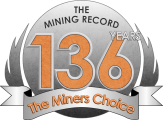PEA Results At Mexican Hat Gold Project
VANCOUVER – GMV Minerals Inc. reported on the Preliminary Economic Assessment (PEA) study of the Mexican Hat Gold Project, located in Cochise County, southeastern Arizona. The Mexican Hat hosts a shallow oxide gold resource with excellent metallurgy and high recoveries, supported by a low strip ratio and minimal pre-stripping. Infrastructure is in place and the Mexican Hat Project demonstrates a robust NPV and IRR. With fast leach kinetics and low reagent consumption, the Company believes the Mexican Hat Project offers exceptional potential economics.
The Base Case generates a pre-tax Internal Rate of Return (IRR) of 66.1% (after-tax 50.2%) and a pre-tax net present value (“NPV) at a 5% discount rate of US$390.2 million (after-tax US$268.3 million) with a 1.53 year payback (1.82 year after-tax) of invested capital using a US$2,500 per ounce gold price. Based on price sensitivity analysis at approximately the current price of US$3,350 per ounce of gold, the project returns a pre-tax IRR of 106.8% (after-tax 82.5%) and a pre-tax NPV at a 5% discount rate of US$767 million (after-tax US$538.1 million) with a payback period of 1.10 years (1.3 years after-tax). Base Case mine life of 10 years with total production of 597,841 ounces, averaging approximately 60,000 ounces per year.
Crushed mineralized material will be conveyor stacked at a rate of approximately 10,000 tonnes/day on a conventional heap leach pad. Capex: US$89,997,000 (including US$15.4 million contingency). Opex: US$788 million LOM with Low LOM Strip Ratio of 2.05. Estimated cash cost of production is US$1,354 per ounce with an all-in-sustaining cost of $1,545 per ounce inclusive of sustaining capital and additional overhead support. Engineering design analysis indicates the potential to increase pit size and contained ounces with increased gold prices.
The Mineral Resource Estimate has been constrained to a preliminary optimized pit shell, using the following parameters: SG = 2.57 gm/cc based on testwork, mining costs = $3.00/tonne, mining recovery = 98%, mining dilution = 2%, process cost = $5.00 per tonne, G&A = $1.05 per tonne, gold price = $2,500 per troy ounce, throughput at 10,000 tpd., discount rate = 5%. A cost of $0.03 was added per bench to the mining cost below the existing level surface. A top cut of 32 gpt gold is applied to all zones except Zone 6 which has a top cut of 50 gpt gold. Mineral Resources constrained to optimized pit shells are not Mineral Reserves and do not have demonstrated economic viability. Conforms to NI 43-101, Companion Policy 43-101CP, and the CIM Definition Standards for Mineral Resources and Mineral Reserves. Inferred Resources have been estimated from geological evidence and limited sampling and must be treated with a lower level of confidence than Measured and Indicated Resources. There are no known legal, political, environmental, or other risks that could materially affect the potential development of the mineral resources.
The mine plan is conceived as a conventional open pit tuck and shovel/loader operation. There are two independent pits which are developed with five-phase or pushback designs. Pit shells were designed using 6.0-meter benches with a catch bench installed every 18 meters. A bench face angle of 66° was used, resulting in an inner-ramp angle of 45° when catch benches were included. An 88% overall gold recovery has been used in this study, which was based on bottle roll and column leach test results. Base case haulage ramps are 26 meters wide and have a design gradient of 10%. Processing rates are based on a daily crushing rate of approximately 10,000 tonnes per day utilizing two stage crushing
The mine and crushing will be operated by contractors with oversight by GMV mine management. The mine plan produces a nominal tonnage to the crushing and heap leach of 3,500 Ktonnes per year (10,000 tpd) from a total material movement of 93.8 Ktonnes for the life of mine (26,106 tpd LOM average).
The PEA is preliminary in nature; it includes inferred Mineral Resources that are considered too speculative geologically to have the economic considerations applied to them that would enable them to be categorized as Mineral Reserves, and there is no certainty that the PEA will be realized. There is no Mineral Reserve at the Mexican Hat Project at this time. Mineral resources that are not mineral reserves do not have demonstrated economic viability. Over the course of the mine life, 38.6 Mtonnes of Mineralized Resource is planned for processing out of a total material movement of 117.8 Mtonnes.
The Mexican Hat Project is located in the southeastern part of the State of Arizona, approximately 72 miles east-southeast of Tucson, and can be accessed from the Old Ghost Town Road., a gravel road extending south of the Town of Pearce or north from Gleeson Road.
Groundwater will be used as the source of water for mining operations. No permitting restrictions or quantity issues are anticipated.
A 69 kV powerline to site will be supplied by Sulphur Springs Valley Electric Cooperative from their power plant located 30 km north of the project site.
The crushing plant will be operated by a contractor to produce a crushed product for heap leaching with a 25 mm top size. Pregnant solution from the heap leach will be processed in a conventional adsorption desorption recovery (ADR) plant. The process plant will produce doré gold bars.
Add Your Heading Text Here
Add Your Heading Text Here
Related Posts
VANCOUVER - Ridgeline Minerals Corp. reported additional assay results for discovery drillhole SE25-053 at the Selena…
VANCOUVER - Nevada Sunrise Metals Corporation has completed surface geophysical and geochemical exploration surveys at…
TORONTO - Omai Gold Mines Corp. reported on the second hole drilled on the Gilt…



